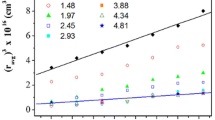Abstract
This study focused on the preparation of a hydrocarbon dispersion of nanospherical silica using tetraethoxysilane homopolymerization by a sol–gel process catalyzed by NH4OH in ethanol. The silica surface was rendered hydrophobic by the introduction of trimethylchlorosilane or trimethylethoxysilane as a terminator. Organophilic particles with diameters in the range 10–130 nm were obtained under controlled conditions. Nevertheless, the organophilic fraction dispersed in hexane was not greater than 62%. The homopolymerization reaction time was directly related to the particle size and, in some cases, its insolubility. High terminator concentration and low termination temperature favored the increase in the number of organophilic particles. The chlorine-containing terminator was more efficient in promoting the production of hydrocarbon hydrophobic nanospheres.
Similar content being viewed by others
Author information
Authors and Affiliations
Additional information
Received: 21 February 2000/Accepted: 21 June 2000
Rights and permissions
About this article
Cite this article
Pedroso, M., Dias, M., Azuma, C. et al. Hydrocarbon dispersion of nanospherical silica by a sol–gel process. 1. Tetraethoxysilane homopolymerization. Colloid Polym Sci 278, 1180–1186 (2000). https://doi.org/10.1007/s003960000380
Issue Date:
DOI: https://doi.org/10.1007/s003960000380




